Alternative estimates of the output gap for the Argentine economy
Keywords:
Alternative Estimation Methodologies, Output Gap, Potential Output, Production Function MethodAbstract
The analysis of the dynamics of the output gap (the difference between the observed output and the non-inflationary potential) is a tool widely used in the structural models used by central banks. In such models, the product gap is a key variable to explain the dynamics of prices and wages. However, despite its potential as a relevant variable for policy decision-making, both potential output and the output gap are not directly observable. For this reason, it is necessary to advance a strategy that allows improving its estimation using alternative methodologies. This work presents various methodologies to estimate the potential product and the product gap in the case of the Argentine economy. In particular, the method based on a neoclassical production function is described. The work also includes estimates of the potential product made from different univariate and multivariate methods such as “State-Space” (Kalman filter), multivariate Hodrick-Prescott (HP) and structural VAR . The final objective of the work is to provide the Central Bank with various tools to estimate potential output, as well as evaluate the relative performance of each of them considering their ability to predict the evolution of inflation.
JEL classification: E22 ; E23 ; E32




